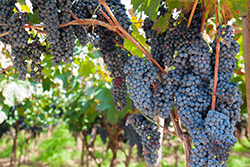Petite Sirah: The Quiet Man with Quite the Punch
Posted by Matteo Lahm on 8th May 2023
Every family has the politician and the stoic. Wine is no different. More well-known varietals like Cabernet Sauvignon and Pinot Noir tend to hog the conversation. But like the old saying goes, some people who talk less actually have more to say. As your winemaking journey expands, surely your curiosity must expand with it. What about discovering varietals that don’t dance on the bar but prefer the role of observer in the corner of the lounge? They can be the most interesting people in the room. That is Petite Sirah. Its rich history and distinct characteristics offer you the opportunity to create a wine that is both unique and captivating. And don’t be fooled by the name. There is nothing petite about the flavors and character of this grape. It is a formidable powerhouse. In the event you notice this intense wallflower, this article will guide you through the rules of engagement, fermentation techniques and nuances of this muscular varietal. Petite Sirah has a whole lot to say if you can start the conversation.
The Petite Sirah grape, often mistaken for its cousin Syrah, has a story of its own to tell. Hailing from the Rhône Valley in France, this grape has found a new home in the vineyards of California, where it has flourished and gained a reputation for producing wines with bold flavors and a velvety texture. As you tend to your vines, you can almost feel the whispers of history in the breeze, as the Petite Sirah grape weaves its tale into your winemaking process.

The distinct characteristics of Petite Sirah begin with its deep, inky color, which sets it apart from other varietals. As you pour your wine into a glass, you'll notice the mesmerizing dance of light and shadow, as the rich hues of purple and blue intertwine. This visual symphony is a prelude to the complex flavors that await your palate.
To truly capture the essence of Petite Sirah, your fermentation techniques must be tailored to its unique qualities. The grape's thick skin and high tannin content require a delicate balance during the maceration process. By carefully managing the duration and intensity of skin contact, you can extract the perfect harmony of flavors and tannins, resulting in a wine that is both bold and elegant.
As you delve deeper into the world of Petite Sirah, understanding the ideal fermentation temperatures and the resulting flavor characteristics at different levels is crucial to crafting a wine that truly reflects your vision. By carefully controlling the internal fermentation temperatures, you can guide your Petite Sirah through a spectrum of flavors, creating a wine that is as complex as it is captivating.
Ideal internal fermentation temperatures for Petite Sirah typically range between 68°F and 86°F (20°C and 30°C). Within this range, subtle variations in temperature can have a significant impact on the flavor profile of your wine.
At the lower end of the temperature spectrum (68°F to 72°F / 20°C to 22°C), your Petite Sirah will develop delicate and nuanced flavors. The cooler fermentation temperature will emphasize the fruit-forward characteristics of the grape, resulting in a wine with bright notes of red berries, such as raspberry and red currant, accompanied by subtle hints of violet and white pepper. This elegant and refined profile is perfect for those seeking a more delicate expression of Petite Sirah.
In the mid-range of fermentation temperatures (73°F to 79°F / 23°C to 26°C), your Petite Sirah will begin to reveal its bolder side. The warmer fermentation environment will encourage the development of richer fruit flavors, such as blackberry, blueberry, and dark cherry. These luscious fruit notes will be complemented by undertones of dark chocolate, licorice, and a touch of earthiness. This well-rounded and balanced profile is ideal for those who appreciate the harmony between fruit and complexity.
As you venture into the higher end of the temperature range (80°F to 86°F / 27°C to 30°C), your Petite Sirah will truly embrace its robust nature. The warmer fermentation temperatures will accentuate the grape's inherent tannins and structure, resulting in a wine with a powerful and full-bodied profile. Bold flavors of black fruit, such as black plum and black currant, will dominate the palate, accompanied by notes of tobacco, leather, and baking spices. This intense and opulent expression of Petite Sirah is perfect for those who crave a wine with depth and character.
The internal fermentation temperature plays a pivotal role in shaping the flavor profile of your Petite Sirah. By carefully controlling the temperature during the fermentation process, you can guide your wine through a spectrum of flavors, from delicate and nuanced to bold and powerful. As you craft your own unique vintage, let the enchanting dance of Petite Sirah lead you on a journey of discovery, as you explore the myriad of flavors that this remarkable grape has to offer.

As you monitor the fermentation, consider punching down more often. The only thing about Petite Sirah that is small is the actual size of the grape. The skins are very thick and more exposure to the alcohol helps get better extraction if you like more robust tannins.
Once fermentation is complete, the next step in your winemaking journey is the aging process. Petite Sirah's robust nature makes it an ideal candidate for aging and oak, which can impart additional layers of complexity and depth to your wine. As you select your oak, consider the type of oak and the level of toast, as these factors will influence the final flavor profile of your Petite Sirah.
Throughout the aging process, be sure to taste your wine regularly, as this will allow you to monitor its development and make any necessary adjustments. Like a skilled conductor, you must guide your Petite Sirah through its maturation, ensuring that each note and nuance is perfectly balanced.
As you uncork your bottle of Petite Sirah, you'll be greeted by a bouquet of aromas that are both bold and enchanting. Notes of blackberry, plum, and blueberry intertwine with hints of spice and leather, creating a sensory experience that is both captivating and memorable. As you savor each sip, you'll discover the true magic of Petite Sirah, and the unique story that it has to tell.
In conclusion, crafting a wine from Petite Sirah is like trying to have a conversation with Beethoven. It is a grape that does not like the limelight but when it finally has its turn, you get hit with the opening notes of the 5th symphony. With the right care and knowhow, Petite Sirah offers you the opportunity to create a truly distinct, memorable and powerful vintage. By understanding the nuances of this varietal and employing fermentation techniques tailored to its unique characteristics, you can make wines that boggle the mind. So, as you embark on your winemaking barhop journey, take notice of the people smiling confidently and quietly. One of them is Petite Sirah and if you work up the courage to say hello, you will be in for quite a surprise.

